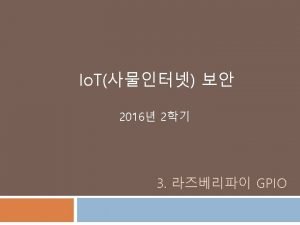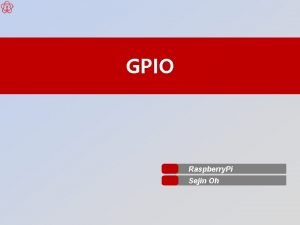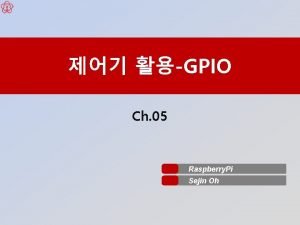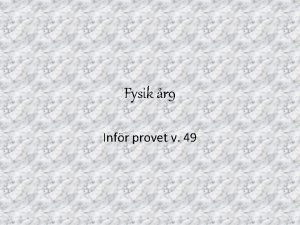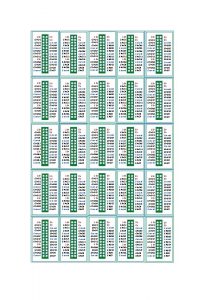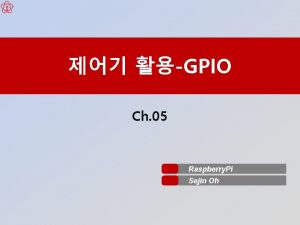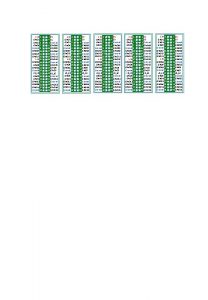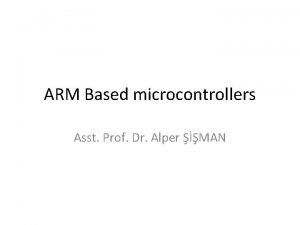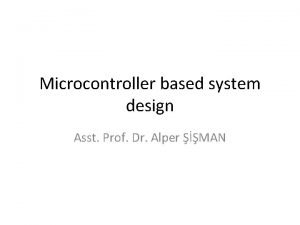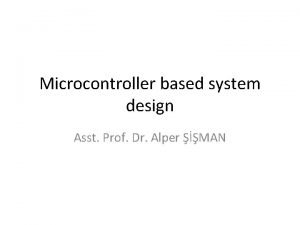Practice 2 Asst Prof Dr Alper MAN GPIO
















- Slides: 16

Practice 2 Asst. Prof. Dr. Alper ŞİŞMAN

GPIO Module • Output states: push-pull or open drain + pullup/down • Output data from output data register (GPIOx_ODR) or peripheral (alternate function output) • Speed selection for each I/O • Input states: floating, pull-up/down, analog • Input data to input data register (GPIOx_IDR) or peripheral (alternate function input) • Bit set and reset register (GPIOx_BSRR) for bitwise write access to GPIOx_ODR

• Locking mechanism (GPIOx_LCKR) provided to freeze the I/O configuration • Analog function • Alternate function input/output selection registers (at most 16 AFs per I/O) • Fast toggle capable of changing every two clock cycles • Highly flexible pin multiplexing allows the use of I/O pins as GPIOs or as one of several peripheral functions • During and just after reset, the alternate functions are not active and the I/O ports are configured in input floating mode.

The configuration steps of GPIO pin • The clock signal of corresponding GPIO HW must be activated: – RCC->AHB 1 ENR: Reset&Clock control reg. ->AHB 1 enable register. • The pins must be defined as input or output – GPIOD->MODER: Mode register 32 -bit for 16 pins:

• The output type must be configured – GPIOD=>OTYPER: • The output speed must be configured – GPIOD=>OSPEEDR: 32 bit register for 16 pins.

• The pull up resistor configuration mus be set – GPIOD=>PUPDR: 32 bit reg. 16 pins

Read/Write Registers • GPIO port input data register: GPIOD=>IDR • GPIO port output data reg. : GPIOD=>ODR • GPIO port bit set/reset reg. : GPIOD=>BSRR

Other GPIO Registers • GPIO port configuration lock reg. • GPIO alternate function low reg. • GPIO alternate function high reg. • Further information can be seen on page 278. (ref manual RM 0090)

Blinking LED • Run in DEBUG mode step by step and see four LED in on and off. • #include "STM 32 F 4 xx. h” • void System. Init() • { • (*((int*)0 x. E 000 ED 88))|=0 x 0 F 00000; // Floating Point donanimini aktiflestir. • RCC->AHB 1 ENR |= 0 x 00000008; // GPIOD donaniminin clock sinyalini uygulayalim • GPIOD->MODER = 0 x 55000000; // GPIOD nin 15, 14, 13, 12 pinleri cikis tanimlandi (Ledler bu pinlerde) • GPIOD->OSPEEDR= 0 x. FFFF; // GPIOD nin tum cikislari en yuksek hizda kullanacagiz • }

• int main() • { • while(1) • { • GPIOD->ODR= 0 x 0000 F 000; • GPIOD->ODR= 0 x 0000; • } // Ledler yansin // Ledler sonsun

Add a delay subrotine • void delayy(){ • int delay 0 = 0 x 000 FFFFF; • while (delay 0 --){ • }

Call delayy from main • int main() • { • while(1) • { • GPIOD->ODR= 0 x 0000 F 000; • delayy(); • GPIOD->ODR= 0 x 0000; • delayy(); • } // Ledler yansin // Ledler sonsun

Read Button • Activate GPIOA clock • Configure A 0 as input (it is default), bus speed and no pull up/down • void System. Init() • { • (*((int*)0 x. E 000 ED 88))|=0 x 0 F 00000; // Floating Point donanimini aktiflestir. • RCC->AHB 1 ENR |= 0 x 00000009; // GPIOD &A donaniminin clock sinyalini uygulayalim • GPIOD->MODER = 0 x 55000000; // GPIOD nin 15, 14, 13, 12 pinleri cikis tanimlandi (Ledler bu pinlerde) • GPIOD->OSPEEDR= 0 x. FFFF; // GPIOD nin tum cikislari en yuksek hizda kullanacagiz GPIOA->OSPEEDR= 0 x. FFFF; // GPIOA nin tum girisleri en yuksek hizda kullanacagiz • GPIOA->PUPDR = 0 x 0000; } •

Stop blinking • When button is pressed the blinking will stop: • int main() • { • while(1) • { • while ((GPIOA->IDR & 0 x 1) == 0){ • } • • GPIOD->ODR= 0 x 0000 F 000; // Ledler yansin • delayy(); • GPIOD->ODR= 0 x 0000; // Ledler sonsun • delayy(); • }

Define D 0 as output&observe it • void System. Init() • { (*((int*)0 x. E 000 ED 88))|=0 x 0 F 00000; // Floating Point donanimini aktiflestir. • RCC->AHB 1 ENR |= 0 x 00000009; // GPIOD &A donaniminin clock sinyalini uygulayalim • GPIOD->MODER = 0 x 55000001; // GPIOD nin 15, 14, 13, 12 ve 0. pinleri cikis tanimlandi (Ledler bu pinlerde+0. pin) • GPIOD->OSPEEDR= 0 x. FFFF; // GPIOD nin tum cikislari en yuksek hizda kullanacagiz • GPIOA->OSPEEDR= 0 x. FFFF; // GPIOA nin tum girisleri en yuksek hizda kullanacagiz

HW#2 • Connect a 7 -segment to the STM 32 F 4 x board • Write a number between 1 -9 on the 7 segment • When user button is pressed number 0 should be seen on the 7 -segment.
 Raspberry pi gpio nodejs
Raspberry pi gpio nodejs Man vs what
Man vs what Man gpio
Man gpio Alper serdar anlı
Alper serdar anlı Dr ismail alper tarım
Dr ismail alper tarım Vertica
Vertica Alper şişman
Alper şişman Egeatasaglik
Egeatasaglik 라즈베리파이4 gpio
라즈베리파이4 gpio Webiopi raspberry pi 3
Webiopi raspberry pi 3 Systeme d'exploitation
Systeme d'exploitation /sys/class/gpio/gpiochip
/sys/class/gpio/gpiochip Module 'rpi.gpio' has no 'setmode' member
Module 'rpi.gpio' has no 'setmode' member Sin entered through one man
Sin entered through one man You live to learn
You live to learn Volym massa densitet
Volym massa densitet A hungry man is an angry man example sentence
A hungry man is an angry man example sentence
